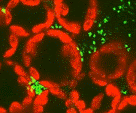Plant Pathology Department
Date of this Version
2-2014
Citation
Molecular Plant-Microbe Interactions Feb 2014, Volume 27, Number 2, pp. 150–162. http://dx.doi.org/10.1094/MPMI-09-13-0272-R.
Abstract
Viral determinants and mechanisms involved in extension of host range of monocot-infecting viruses are poorly understood. Viral coat proteins (CP) serve many functions in almost every aspect of the virus life cycle. The role of the Cterminal region of Wheat streak mosaic virus (WSMV) CP in virus biology was examined by mutating six negatively charged aspartic acid residues at positions 216, 289, 290, 326, 333, and 334. All of these amino acid residues are dispensable for virion assembly, and aspartic acid residues at positions 216, 333, and 334 are expendable for normal infection of wheat and maize. However, mutants D289N, D289A, D290A, DD289/290NA, and D326A exhibited slow cell-to-cell movement in wheat, which resulted in delayed onset of systemic infection, followed by a rapid recovery of genomic RNA accumulation and symptom development. Mutants D289N, D289A, and D326A inefficiently infected maize, eliciting milder symptoms, while D290A and DD289/290NA failed to infect systemically, suggesting that the C-terminus of CP is involved in differential infection of wheat and maize. Mutation of aspartic acid residues at amino acid positions 289, 290, and 326 severely debilitated virus ingress into the vascular system of maize but not wheat, suggesting that these amino acids facilitate expansion of WSMV host range through host-specific long-distance transport.


Comments
U. S. government work.